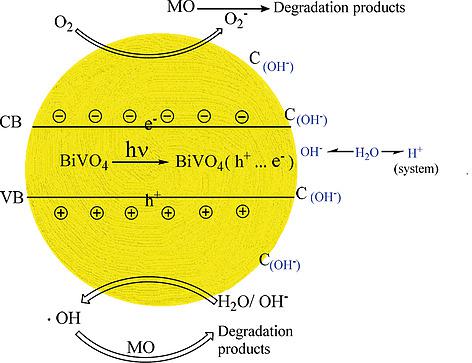当前位置:
X-MOL 学术
›
Z. Anorg. Allg. Chem.
›
论文详情
Our official English website, www.x-mol.net, welcomes your
feedback! (Note: you will need to create a separate account there.)
Synthesis, Characterization, and Photocatalytic Activities of BiVO4 by Carbon Adsorption Hydrothermal Method
Zeitschrift für anorganische und allgemeine Chemie ( IF 1.1 ) Pub Date : 2020-08-13 , DOI: 10.1002/zaac.202000141 Y. T. Niu 1 , G. B. Guo 1
Zeitschrift für anorganische und allgemeine Chemie ( IF 1.1 ) Pub Date : 2020-08-13 , DOI: 10.1002/zaac.202000141 Y. T. Niu 1 , G. B. Guo 1
Affiliation

|
A new idea of prepared method for BiVO4 nano‐powders hydrothermal synthesis process was developed to avert the existent shortcomings of hydrothermal method. The thermal stability, phase structure, light absorption property, and morphology of the catalyst prepared were characterized by thermogravimetric analyzer (TG), X‐ray diffraction (XRD), ultraviolet visible spectrophotometer (UV/Vis), and transmission electron microscopy (TEM), respectively. Using methyl orange (MO) as the target degradation material and a 500‐W dysprosium lamp as the visible light source to investigate photocatalytic performance of BiVO4. We successfully prepared BiVO4 powders with small particle size, less agglomeration and uniform distribution by carbon adsorption hydrothermal method, and the absorption wavelength of light was red‐shifted, these all rendered the absorption capacity of visible light region enhancing with 94 % high photocatalytic degradation rate of methyl orange at 60 min. And the possible mechanism was also discussed in this study.
中文翻译:

碳吸附水热法合成BiVO4,表征及光催化活性
提出了制备BiVO 4纳米粉体水热合成方法的新思路,以克服水热法存在的不足。通过热重分析仪(TG),X射线衍射(XRD),紫外可见分光光度计(UV / Vis)和透射电子显微镜(TEM)对所制备催化剂的热稳定性,相结构,吸光性能和形态进行了表征。 , 分别。使用甲基橙(MO)作为目标降解材料并使用500-W lamp灯作为可见光源,以研究BiVO 4的光催化性能。我们成功地准备了BiVO 4碳吸附水热法制得的粒径小,团聚少,分布均匀的粉末,光的吸收波长发生红移,这些都使得可见光区的吸收能力提高,甲基橙的光催化降解率为94%。 60分钟 并且在本研究中还讨论了可能的机制。
更新日期:2020-08-13
中文翻译:

碳吸附水热法合成BiVO4,表征及光催化活性
提出了制备BiVO 4纳米粉体水热合成方法的新思路,以克服水热法存在的不足。通过热重分析仪(TG),X射线衍射(XRD),紫外可见分光光度计(UV / Vis)和透射电子显微镜(TEM)对所制备催化剂的热稳定性,相结构,吸光性能和形态进行了表征。 , 分别。使用甲基橙(MO)作为目标降解材料并使用500-W lamp灯作为可见光源,以研究BiVO 4的光催化性能。我们成功地准备了BiVO 4碳吸附水热法制得的粒径小,团聚少,分布均匀的粉末,光的吸收波长发生红移,这些都使得可见光区的吸收能力提高,甲基橙的光催化降解率为94%。 60分钟 并且在本研究中还讨论了可能的机制。











































 京公网安备 11010802027423号
京公网安备 11010802027423号